Hawaii officially designated January as “Kalaupapa Month” when the legislature passed a bill and signed it into law in 2021. This honors and remembers Kalaupapa residents, past and present. It was January 1866 when the first 12 people affected by leprosy arrived on Molokai at the isolated Kalaupapa peninsula. The ship taking them never docked. They were forced to swim to shore in the area seen in our photo below.


Those 12 were the first of almost 8,000 people sent to Kalaupapa following the decree from King Kamehameha V. Most were never seen again. That occurred from 1866 to 1969, although forced isolation stopped in 1949. People were forcibly taken from their homes, even children, and placed into isolation there due to leprosy diagnosis, now called Hansen’s disease.
In 1873, Father Damien left the “outside world to take care of Hawaii’s Hansen’s disease patients in quarantine. Mother Marianne Cope, followed him. Both are now recognized as Saint Damien and Saint Marianne Cope. These two and others came when there was no cure for the disease, and Damien gave his life to care for the people.
No matter how often we have been to the sacred ground of Kalaupapa National Historical Park, just thinking about it still gives us chills. The intense suffering, sorrow, and despair that took place there with the forced exile of patients from their homes and families due to the spread of leprosy are both tangible and unforgettable.
The last few residents alive have been free to leave Kalaupapa for decades, yet choose to stay. Once a prison, now a refuge, Kalaupapa is their home.
Kalaupapa is a spiritual place of great beauty and a reminder of tremendous suffering in what was referred to as the “leper colony.” It stands totally apart and isolated from the rest of the island of Molokai.
Kalawao County, Hawaii.
The Kalaupapa peninsula is a separate county in the state of Hawai`i, being Kalawao County, rather than being “entirely” part of Maui County, as is the rest of Moloka`i. The state health department manages it.
Kalawao is the smallest county in the US, as determined by land area. Because of its small size, the county doesn’t have normal county functions. It is instead a judicial district of Maui County and does not have its own elected officials.


Beat of Hawaii at Kalaupapa.
Before it was closed, we hiked down to the settlement (seen in our photo above), one of Hawaii’s most iconic and hallowed places. What remains of the original Kalaupapa settlement on the Kalawao area of the peninsula are both ruins and buildings that were successors to the original two churches. In the early years, the leeward Kalaupapa side of the peninsula remained a Hawaiian fishing village, but in 1895 the provisional government forced the original inhabitants to leave. Slowly the Department of Health shifted its settlement to this more temperate side of the peninsula.
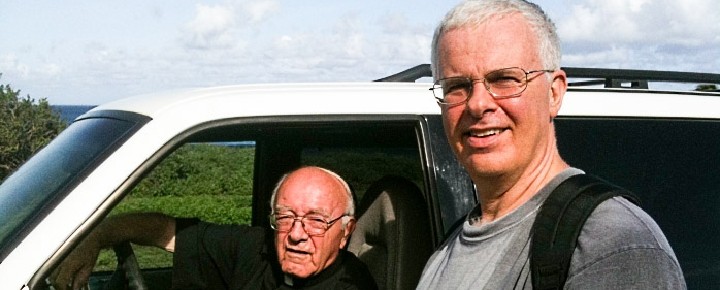

When we trekked the hundred-year-old Pali trail, we were in part there to visit Father Felix (seen here with Beat of Hawaii editor Rob). He was a Belgian priest and a fixture in Hawaii for a half-century. Father Felix served at St. Francis of Assisi Catholic Church at Kalaupapa, following in the footsteps of St. Damien and ministering to Hansen’s Disease patients. We also had the opportunity to visit the original settlement area at Kalawao. It is simply something neither of us will ever forget. We decided to skip the mule ride, which was still operating, for personal reasons. Beat of Hawaii’s mascot is an actual pet mule who is cared for by editors Rob, Jeff and Collin. So we chose instead to experience the history of this venerable trail on foot. It was arduous and worth every step.
Since Covid, Kalaupapa has remained closed to the general public.
The closure includes all access to the trail and fly-in access to Kalaupapa Airport. The trail was closed initially due to a landslide that occurred in 2018 and then during Covid. The federal government appears to have restored trail access. The National Park Service is not issuing permits, however. Part of the issue is that visitors had to be on a tour to visit. There is currently no concessionaire.


Kalaupapa Legend: Richard Marks.
When we went, it was with Damien Tours, owned by the late Richard Marks and his wife Gloria (pictured above). He was our tour guide. Marks was born on Maui in 1929 and contracted leprosy when he was 21 years old in the Merchant Marines. He was sent to Kalaupapa in 1956, where his father, sister, brother, and other relatives had been sent. After Marks, a new tour group started and is no longer in business.
Richard Marks had an enormous impact on modern-day Kalaupapa, arguably more so than anyone else. In 1967 he contested Hawaii’s outdated laws on leprosy, by which patients were treated more like criminals. Then a few years later, as Kalaupapa residents became fearful of being removed from their homes to make room for luxury development, he reached out to the National Park Service to step in and help preserve both the lifestyle of the current residents and the history of Kalaupapa for all future generations.
Marks is also said to be the person who helped spearhead the canonization of Father Damien to sainthood.
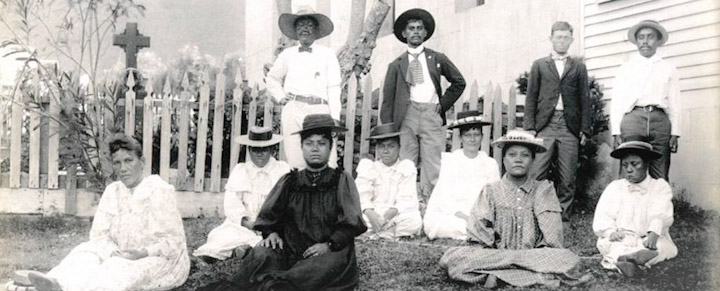

Update on patients at Kalaupapa – Only nine are still living.
While antibiotics cured the illness Hanson’s Disease (leprosy), patients already at Kalaupapa could still live there. That number has dwindled down to nine still living. In order to visit during this closure of Kalaupapa, you must be sponsored by a resident or employee. Once the last patient dies, the area will revert back to Hawaiian Homelands (which it was before, when Native Hawaiians lived there). The National Park Service currently leases it. What happens in the future is unclear to us and to those we spoke with to prepare this article.
There are currently 650 cases of Hanson’s Disease in Hawaii and about 12-15 new cases a year. The treatment program lasts two years.
If the Pali trail reopens, here’s what to expect.
The trail is challenging, slippery, and muddy. The incredible sheer cliffs overlook the Pacific Ocean on the north shore of Molokai and descend from 1,700 feet with the North Shore Pali to the east. According to the Guinness Book of World Records, these are the tallest sea cliffs in the world. After the three-mile hike (which seems much farther), including the 26 switchbacks that are marked, you arrive at sea level and are bussed to the historic town, perhaps the most remote settlement in Hawaii.
The hike to the bottom took us 2 hours and 15 minutes, much longer than we had expected. When we heard the sound of the surf and looked up the cliff from where we started, it was exhilarating knowing we had arrived. Going back topside after the tour was much easier psychologically without as much chance of slipping, but still strenuous.
We felt some soreness for a few days after. Despite the discomfort, it was worth the experience, and we recommend this journey (when it again becomes accessible) to all in good condition.
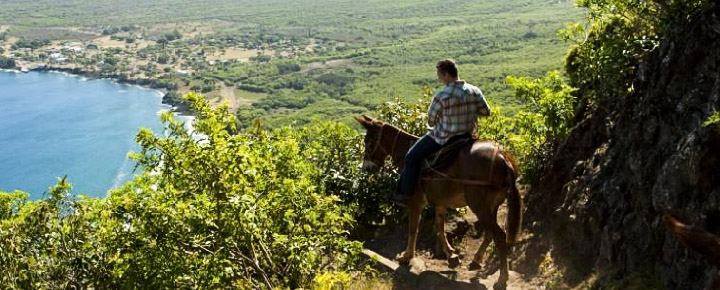

What happened to the iconic mule rides?
One of Hawaii’s most famous tourism activities was the mule ride to Kalaupapa on the same trail we hiked. That ride is closed permanently, which is unrelated to the closure of the hiking trail.
The mule ride operators were evicted from the land after operating the attraction for 40 years. According to the landowner, they were trying to achieve a new agreement with the ride operator, but that, ultimately, did not work out. The ride operators indicated that the proposed costs were too great for their operation to remain viable. At the same time, the landowner said that the ride failed to pay rent or provide proof of insurance. “This is not about greed or stopping a business from operating mule rides or tours to Kalaupapa to share the history of Molokai,” said landowner Paul Meyer. “They left us no choice but to evict them from our property.”
What were your impressions of Kalaupapa?
Lead photo: Awahua Beach, located at the end of the trail at Kalaupapa.
Our thanks to the Hawaii Department of Health, Hansen’s Disease Division, for their help with today’s article.
Get Breaking Hawaii Travel News
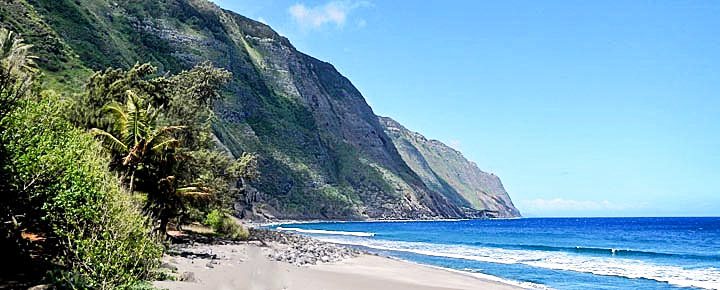
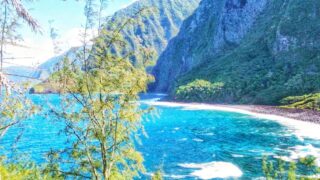
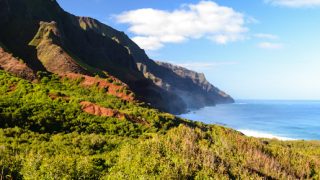
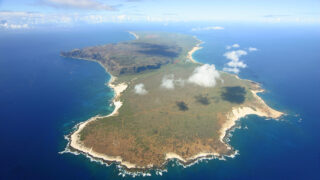
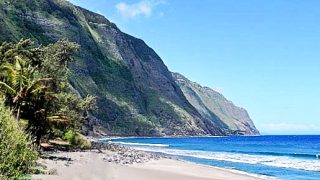
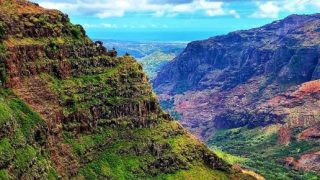
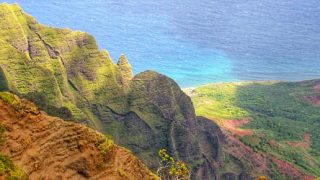
I was lucky to hike down Kalaupapa in 1991. Despite being in reasonably good shape it was a challenging hike. On my descent the view was obscured with fog. It was a wet, humid and sloppy hike due falling in the mud and horse manure that covered the steep trail. As I got closer to the bottom I could see the ocean below and the lovely green peninsula. Absolutely breathtaking!
Richard Marks of Damien Tours met me at the end of trail and i paid the nominal fee ($15 or $25 – I can’t remember). He drove a school bus and showed me the ghost town, the church where St. Damien preached and provided a lovely picnic lunch. Then the tough hike out! Have dreamt many times of returning – very spiritual place! Please no condos!!!!!!
We flew into Kaulaupapa around 2002-2004 and Richard Marks was our guide. It was such a unique and touching experience that I will never forget. Thanks for writing this article and bringing back memories. I hope that when the last residents have passed this place can be preserved as a memorial
We have been to Molokai many times but never made the trip down to Kalaupapa due to my wife’s height issues. I think it would be great if there was an excursion boat that went either from Maui or around the corner of Molokai to see St. Damien’s place of missionary work. As a young child I read “Damien the Leper” and was scared because I thought Hanson’s disease and Biblical leprosy were the same (they’re not). Anyway, we’ve recently read “Molokai” and “Daughter of Molokai” by Bremmert which I highly recommend.
I have always thought that leprosy in the Bible and Hansen’s disease are the same thing. The only difference we are in different times and we have a cure now. The disease only had one name until a man named Hansen saw it under a microscope.
One of the best experiences of my lifetime has been the hike down the seacliff to Kalaupapa and, more so, the tour of the former leper colony. Seeing the beauty of this tragic place, learning about the suffering of so many people and Father Damien’s work firsthand was very humbling and inspiring. Please open again soon.
Best
Martina
I went to Kalaupapa february 2003. I knew father felix rather intimately as well. He was at st rafaels koloa last time I saw him.
Our tour guide and bus driver was a journalist, photographer.
His name eludes me, and later in the tour, I realized he was a patient. I’d like to know his name again.
Thank you for this informative article! My husband’s grandfather was born in Kalawao in 1894, and his great-grandfather was buried there years later. Grandpa was hanai’d to a family in topside Molokai immediately after his birth, then sent to relatives on Hawai’i Island to be brought up.
It was important to us to visit Kalaupapa and we hoped that Richard Marks would be our tour guide, which he was. It was the most memorable trip of our lives. We had read several books about Kalaupapa and Father Damien, and to be there was almost spiritual. Richard and Gloria Marks were delightful people.
The National Parks Service was kind enough to send me a photo of our great-grandfather’s grave, as we were not permitted to visit the cemetery.
Mahalo.
Hi Nancy.
Thanks so much for sharing those touching personal details. We had the same feeling about Gloria and Richard.
Aloha.
It’s history that is here and it should never be gone ! So many people lived there against there wishes and to be forced to live there it heart breaking that they had to put up with it.
Both my wife and I have read some info about this site and we’re very interested in the story of what we thought would happen to these poor suffering family’s
We hope as time goes on that the next generation of people would continue to recognize that this is an history of what happened . Gladly they found a cure , and that helped .
Thanks for writing this article as it was very informative for me. My family has a very long history on the islands and especially on Maui, where my grandmother is has lived there since the 40’s after coming over from Oahu. She is now 106 years old and talk to her about the history of Hawaii.
I love this article and thank you for writing it. I was blessed to have went about 18 years ago. I was required to walk down the trail after the mules because of over booking. I was told to try to keep up with the mules because they would only wait 10 minutes for me. After walking down and back I was so sore I could hardly walk for 3 days. Still I would do it again. The day was life changing, including almost missing the last ferry back to Maui.
I will never forget sitting in the old church and seeing the holes in the floor so the people could spit out the blood from the sores in their mouth.
Not open since Covid? I hope the NPS isn’t funding this disgusting endeavor as it is an obvious lack of work ethic!
We visited Molokai for 4 days in 1985 for our 25th Wedding Anniversary. One day we rode the Mules down the cliffs to visit Kalaupapa. Ike was our tour guide. He had lived there since he was 16 because of leprosy. He said it was his home and he never wanted to leave! Being in Father Damian’s Church was very Spiritual! We sat in a hot tub for about 4 days afterwards! I have read many books about the area and the history of people affected by Leprosy.
We were so fortunate in 2015 to take the Molokai ferry from Lahaina and do a day tour of the island. Even though we only saw Kalaupapa from the lookout the experience was profound and one of my most cherished memories of visiting the islands over the last 30 years. Thanks so much for posting this.
That’s how we saw Kalaupapa-from the lookout.
Elizabeth It looks like a nice place and love the water.
Many years ago, my husband and I were fortunate enough to participate in a tour with Mr. Marks. It was a fascinating, inspiring experience. Upon his death, we sent his wife, Gloria, our condolences, and received a gracious response. Memories of a lifetime.
Aloha no. I have been to Kalaupapa on many occasions. My aunt , Nellie Kaimuki Hueu McCarthy(my mother’s sister) and her husband Fred McCarthy were residents there. She was our sponsor back in early 70s. I actually had the privilege of hiking into Waikolu Valley, courtesy of 2 young men who worked for State of Hawaii back then. What a beautiful experience. Was sad to learn that many of the residents families never acknowledged that they had a relative there. But on the other hand, there were those who often visited their ohana there. Thank you for this article much appreciated.
I have traveled to Moloka’i many times & have been fortunate to visit Kalaupapa on multiple occasions. This is one of the most sacred places I have ever visited. Rick Schonely, one of the most recent tour guides (before Covid closed the tours) on Monday and Tues, is a great friend of mine and his aloha of Kalaupapa is second to none. I have been privileged to perform Wahine ʻIlikea with him on our ukulele’s at St. Philomena’s Catholic Church, the 1st church Father Damien built there. It was always a great pleasure to talk story with the late Uncle Boogie who worked in the bookstore.
Readers may be interested in the Ka’Ohana O Kalaupapa organization working to honor those who lived there and their ohana kalaupapaohana.org
I have a friend whose name is Fermin. He is full blooded Apache Indian. He did degrees in both forest management and art at UC Davis. Fermin was heavily connected into the Catholic church. He was one of the guards for the Kalaupapa leper colony. For him it was a life changing event. He did a series of artworks on the experience of working at the leper colony. This work took several years of his life. I curated a show for him of perhaps 80 works in total in the mid 90s. We also own one of his works. His work deals with leprosy, the church, and being in the leper colony. His work is beautiful in its own way. Fermin’s full time career is being a California park ranger.
I shot touch and goes at the Kalaupapa airport in 2003 and 2004. We did not stop, just touched the runway and took off again. The airport is closed now?
Still open and served by Mokulele. You can ride along HNL-LUP-MKK and see the area from the plane.
no, the airport is not closed
What a fascinating place. I was on Molakai last year and looked down to the peninsula from Palaapu State Park Overlook. I so wanted to venture down to the peninsula.
Please comment more on this fascinating historical place and pray it doesn’t become a fancy resort for the rich. I read your weekly articles and love all you write about Hawaii! Thank you. Anthony W
Hi Anthony.
Thanks for your nice words and for being a regular reader. Also, for this your first comment.
Aloha.
Wow, I feel honored. I hope to comment more often now. Thank you so much, and yes I look forward to your articles. Such a pleasure. Mahalo
I stand updated. Even though Biblical Leprosy is specifically called out, it appears as though The WHO uses the term interchangeably:
answersingenesis.org/biology/disease/biblical-leprosy-shedding-light-on-the-disease-that-shuns/
The historical novel “Moloka’i,” by Alan Brennert, introduced me to this fascinating, and heart-breaking piece of history. Please offer your comments on that book. Do you recommend it as truthful? Mostly truthful? Pure fiction? Mahalo!
Hi Andy.
One of us read the book years ago and recommends it. While the well-written book has fictional characters, it is based on actual events, and it captures the human drama and emotions of people who were forced to go there and live their lives there. So you may come away with more feelings about Kalaupapa.
Aloha.
Thank you! Now I want to read it again!
I have one more comment regarding leprosy; leprosy as today’s defined bacterium is not the same as historical leprosy. Historical leprosy, such as Biblical leprosy, was descriptive of several skin conditions such as rashes, athletes foot (which is a fungus) and other ailments. Some of these, such as athletes foot, are quite contagious, thus making leprosy quite contagious by association and grouped in the leprosy pool. I mention athletes foot because it can be spread from one location on the body to other locations via scratching, etc. And it can look like the skin is rotting.
According to American Leprosy Missions; “The medical name for leprosy is Hansen’s disease. Norwegian doctor Armauer Hansen was the first to view the bacillus under a microscope in 1873.” The CDC also confirms the renaming of leprosy to Hansen’s Disease, recognizing Armauer Hansen’s identification of the bacterium that causes leprosy. Mayo Clinic also confirms Hansen’s Disease is the same as leprosy.
Although leprosy (Hansen’s Disease) is still around today it is very treatable with antibiotics. And it is not very contagious, about 95% of us have a natural immunity to it. Hopefully the antibiotics needed will increase in availability for the entire world.
Incidentally, World Leprosy Day is annually the last Sunday of January.
We visited Molokai in August this year. We stopped at the historic lookout and on our flight back to Maui received a spectacular parallel flight along the north shore. It was a spectacular view. The 24 hour trip was full of learning about the history of the colony and experiencing a much different Hawaiian culture. What a wonderful experience.
Hello. I am traveling there in February and was hoping to get to make it to that area. When you went there was no way of getting to the penninsula to meet up with someone to give a tour?
As of now, there is no access to the area and it is completely restricted. Since Covid, all tours have been shut down and the only way to access that part of the island is to be invited by a resident of the settlement.
Hey Juli, yes the flight back to Maui is indeed spectacular! The most amazing airplane ride I’ve ever experienced. I hope to do it again someday.
Great article. Just one correction, though. In 3 separate Molokai books the authors point out that Hansen’s disease is not leprosy at all (as in Biblical times). It may be slightly related due to its flesh eating symptoms, but it is not leprosy.
I will get the titles for you (not with me at the moment).
Mahalo for a great article. Visiting from Calif. in 1998, I went to Molokai solo for several days. I went to honor my Hawaiian-ness and made a trip to Kalaupapa a priority. I rode a sweet little mule down and back. Too bad I wore *white* pants. Numerous trail puddles, mud and, well, “you know” destroyed my duds. What a mess (but soooo worth it)!
Thank you for this update!
I did the hike in the early 2000’s. It was a profound, humbling experience.
I didn’t remember it was the original boat that didn’t dock, but knew those following were thrown in the ocean and had to fight the waves, rocks and cliffs to reach the island!!
If I recall they also stated in the early years if a baby was born healthy, the baby was sent to the mainland?
That thought alone was mortifying to even fathom.
I have not been back since but thank you for this reminder as I would love to share the experience again with my family if/when it reopens!
Aloha!
Thank you for such a fascinating article. Most of us have heard about the island and it’s historical significance. But I, for one, have never seen the true beauty of Molokai. I would love to take the mule ride trip. I spent many winters on Oahu, and miss it so much. I love to see articles on topics other than airline fares,etc. Keep articles on these beautiful locations and attractions coming.
Aloha! We independently hiked the trail in 1995 and thoroughly enjoyed the tour at the bottom. Our guide worked for or was contracted by the National Park Service. He was a resident who had been exiled there when he contracted Hansens Disease. It was such a beautiful place and an amazing story, told firsthand by someone who experienced it. Yes, the hike was strenuous, and we were sore, but it was so worth it! Mahalo for this informative article.
I have traveled down to Kalaupapa and back two times by mule. The journey down was both terrifying and exciting.
Once there I was overcome with a peaceful feeling that I will never forget. I am ever grateful that I was able to experience it.
Aloha Guys! Thanks for the informative and interesting article. I had always wondered about the history of the “leper colony” and how it came to be. It is nice to know that it was renamed and that the patients who are still living are able to call it home.
We are saddened to hear that you can no longer ride the mules to the settlement. That was one of the most moving and incredible experiences of our lifetime. We talk about it every time we go to Hawaii and would do it again if available. The hike would also be awesome and we hope it opens soon so more people can experience this incredibly moving tour. Thanks for the nice article.
It was a very interesting article and very informative.
My late husband had an uncle that was sent there,his uncle was misdiagnosed but by the time they found out his uncle met his future wife. He refused to leave. They had two sons, one died when born and the other was sent to oahu to live with his grandparents (my husband was raised by them also) his uncle, his wife and child are buried there. It’s sad no one could ever visit their grave site.
Very interesting story
I went to Kalaupapa in 2019 and I took a plane from topside Moloka’i to the peninsula. At that time there were 11 patients still alive. Rick Shonoly was the guide to the tour I took and he was so informative. Since there were only three of us on the tour that day, Rick asked Sister Barbara Jean to take us into the convent and give more information on Mother Marianne Cope. I really enjoyed this tour. Kalaupapa felt so peaceful and quiet. There was a spiritual feeling to the peninsula. I’m sorry that no one else gets to experience what I did that day. I know Rick felt a camaraderie with the patients, the sisters, the priest and workers there .
It is a beautiful, serene and informative place, which is definitely worth a day trip. I hope a concessionaire similiar to Damien Tours can be secured soon, along with a flight schedule. It’s the only viable way to control tourism and insure visitor and resident safety.
I would have to take a plane to Kalaupapa. I couldn’t do the walk and the mule ride scares me. I was wondering exactly how many patients were left. Thanks for clarifying it is 9. I would like to look around for the history and beauty.
Hi Carol.
We’ll update this with any changes regarding a potential reopening of Kalaupapa. It isn’t clear that will happen, however.
Aloha.
A very compelling article, Mahalo.
Hi Kauaidoug and Megan M., Debi and others
Thank you for your kind words!
Aloha.
Thank you for this story/article. I love learning about the history of Hawaii.
Have you ever heard Uncle Larry sing his song “Father Damien of Molokai”? Unfortunately that won’t happen again but I could probably sing it in my sleep I’ve heard it so many times.